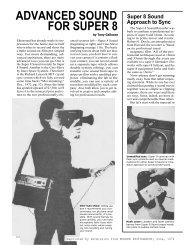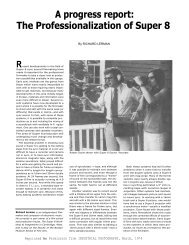Super 8 Sound Inc. - Desktop Video Group
Super 8 Sound Inc. - Desktop Video Group
Super 8 Sound Inc. - Desktop Video Group
You also want an ePaper? Increase the reach of your titles
YUMPU automatically turns print PDFs into web optimized ePapers that Google loves.
<strong>Super</strong> 8 <strong>Video</strong><br />
How Good Is <strong>Super</strong> 8 on TV?<br />
<strong>Super</strong> 8 image quality — assuming use of the finest resolution<br />
fil m available in the <strong>Super</strong> 8 format, Kodachrome 40, and<br />
assuming camera lenses of the highest optical quality available<br />
— can achieve 100 lines per mm resolution. The <strong>Super</strong><br />
8 frame is 4.2mm high by 5.7mm wide, giving a horizontal<br />
resolution in excess of 500 lines, which is comparable to the<br />
finest 2" quad videotape equipment and to broadcast-standard<br />
resolution. By comparison, the 3/4" videocassette<br />
( U-matic) recorder has a horizontal resolution of only 240<br />
li nes, and the home video format of the future — <strong>Video</strong>disc —<br />
is expected to have only 300 lines resolution.<br />
There is of course a distinctive change in the video image<br />
quality whenever the original medium is film, rather than<br />
video camera or video tape. Characteristic differences between<br />
film and video in their dynamic contrast range, and<br />
associated color shifts, produce the familiar "film" look, as<br />
compared to the "live video camera" look. But this look<br />
of film is the same whether the original film is 16mm or<br />
<strong>Super</strong> 8. With a crisp <strong>Super</strong> 8 original, with image enhancement<br />
as is generally used for 16mm film transfers, and with<br />
electronic color correction, it is extremely difficult to distinguish<br />
<strong>Super</strong> 8 from 16mm in off-the-monitor tests reported<br />
in the SMPTE Journal.<br />
<strong>Super</strong> 8 Television Film Apertures and Safe Areas<br />
Kodak <strong>Super</strong>matic<br />
Film <strong>Video</strong>players<br />
The Kodak <strong>Super</strong> 8 Film <strong>Video</strong>player replaces an entire conventional<br />
telecine film chain — including telecine projector,<br />
optical imaging system, and color video camera — at a price<br />
about one-tenth the lowest-cost 16mm film chain. It does<br />
this with a device known as a flying-spot-scanner.<br />
The <strong>Video</strong>player moves <strong>Super</strong> 8 film continuously (no intermittent<br />
motion) past an aerial image of a small TV screen.<br />
The screen has no picture on it, just a gray raster-scanning<br />
pattern. The image of the screen is the same size as a <strong>Super</strong><br />
8 picture frame, and falls directly on the film. If the image<br />
could be seen in micro second intervals, it would appear to<br />
be a small spot (the image of the spot where the electron<br />
beam falls on the TV tube phosphor), raster scanning back<br />
and forth across the <strong>Super</strong> 8 frame. Three photomultiplier<br />
detector tubes (Red, Green, Blue) on the other side of the<br />
fil m measure the color of the spot from moment to moment<br />
and convert the result into a full NTSC standard composite<br />
color signal. There is no color camera.<br />
48<br />
<strong>Super</strong> 8 <strong>Sound</strong>, <strong>Inc</strong>.<br />
95 Harvey Street. Cambridge. Mass. 02140<br />
S8S# VP1, S8SR, K V1910<br />
The Kodak <strong>Video</strong>player is an enormous engineering breakthrough<br />
that expands the options of a <strong>Super</strong> 8 film producer<br />
to include video distribution of his films as well as normal<br />
projection. <strong>Super</strong>8 <strong>Sound</strong> was selected by Kodak to be in<br />
the first group of dealers for the Kodak <strong>Video</strong>player, and<br />
we are franchsied to sell the <strong>Video</strong>player nationwide. A<br />
combination of a <strong>Super</strong>8 <strong>Sound</strong> film production system and<br />
a Kodak <strong>Video</strong>player is the lowest cost independent video<br />
production system with color, editability, and extreme location<br />
portability.<br />
Kodak Film <strong>Video</strong>player VP-1<br />
The VP-1 accepts <strong>Super</strong> 8 film, color or black/white, sound<br />
or silent, on standard <strong>Super</strong> 8 reels or automatic-loading<br />
<strong>Super</strong>matic cassettes (400 ft. maximum — 20 minutes). It<br />
operates at 24fps or 18fps, and converts the <strong>Super</strong> 8 picture<br />
fil m into a standard color television signal that can be displayed<br />
on an ordinary color television receiver or a color<br />
monitor. <strong>Sound</strong> is derived from the magnetic edge stripe of<br />
a single-system film, or from <strong>Super</strong> 8 fullcoat magnetic film<br />
being played back in synchronism on a double-system sync<br />
recorder (<strong>Super</strong>8 <strong>Sound</strong> Recorder).<br />
Kodak <strong>Video</strong>player controls include still frame capability,<br />
framing adjustment for still and running frame, a vertical<br />
steadiness adjustment, blue/red tint control, and focus.<br />
RF signal outputs are channels 2 or 3. A switch is provided<br />
to select between the <strong>Video</strong>player or the VHF antenna of<br />
an ordinary color TV set. <strong>Video</strong> signal output is a fully interlaced<br />
(525 lines) NTSC composite video, with a separate<br />
audio. These signals are suitable for display on a color TV<br />
monitor, or recording on a video-tape recorder.<br />
Kodak Film <strong>Video</strong>player VP-X<br />
The VP-X has the same specifications as the VP-1 except that<br />
it has no RF-modulated output, and it is equipped to accept<br />
external synchronization for use in broadcast situations, or<br />
where a large video system is run on system-wide "station<br />
sync". The external sync inputs include burst flag, composite<br />
blanking, vertical drive, composite sync, horizontal drive, and<br />
color sub-carrier (BNC connectors). The outputs are composite<br />
video 1V peak-to-peak across 75 ohms (BNC connector),<br />
and a 600-ohm unbalanced audio signal (RCA phono jack).<br />
Signal/rms noise ratio is greater than 37dB. Horizontal<br />
resolution is 240 lines — color. No time-base correction is<br />
required.








